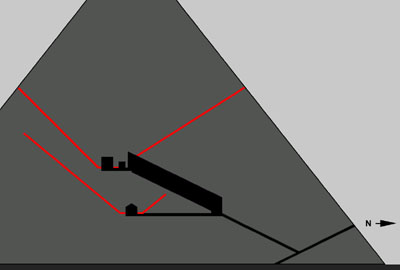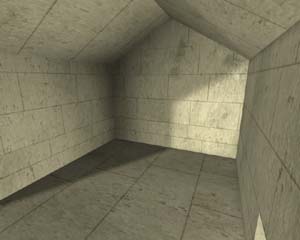|
THE " Y MYSTERY"
Unraveling the "Y Mystery" that is, WHY there are shafts in the Cheops pyramid necessitates a bit of background information.
The many monuments in Egypt all display an evolutionary history which can be traced through time. In the case of the pyramids, we know that the stunning structures of the Giza Plateau all had predecessors. Before them, the Egyptians built square step-pyramids. Before that, they erected rectangular step-pyramids and right at the start, the so-called "mastaba", which were basically just large, slope-walled rectangles, rounded at the top.
So we can follow the expertise of the builders through the centuries, until it culminates in the structures of the Old Kingdom, whose features we can detect in the more primitive forms of earlier epochs.
That is, of course, with the single exception of the shafts of Cheops. These striking features are unique, they have neither precursors nor antecedents. There were no shafts in earlier pyramids, there were none in later constructions.

The mysterious shafts of the Cheops pyramid, shown in red.
Indeed, some early books on Egyptology cite the two small rectangular indentations in the burial chamber of the later Chefren pyramid as antecedents of the Cheops shafts. But the Chefren indentations are only a few inches deep, and in no way constitute even rudimentary shafts. Since our video mapping of the Cheops shafts, we know that they are by no means simply "implied" or insinuated they are complicated, extremely long architectural features, which required enormous extra effort to build into the overall structure. Thus, the Chefren indentations in no way constitute a parallel to or antecedent of the Cheops shafts.
Since the Cheops shafts all measure only about 20 by 20 cm (8 x 8 in.), they were obviously never designed for human passage through them. So what were they for?
Over the years, many suggestions have been made:
1) They are "Air shafts."
Well, the answer to this is a straightforward "No". The lower shafts were closed at both ends. The upper ones if they had been left open as air shafts would have exposed the burial chamber to birds, snakes, rats, etc., an idea certainly abhorrent to those dedicated to protecting the remains of the pharaoh at all cost.
2) They are light or "star shafts."
No! All the shafts bend, often several times. In addition, all the shafts begin, at their lower ends, with horizontal sections about 2 meters in length. So there is no way light from any source could ever have penetrated from the outside into either of the chambers. In several parts of the shafts, with the exception of the lower southern one, we even found extreme angle fluctuations. It is therefore ridiculous for anyone to claim that the shafts could ever have pointed precisely to certain stars. Given the many angle fluctuations, the shafts could be construed to be pointing at some 100 different stars, especially if construction of the pyramid is gratuitously redated to match specific stellar constellations.
3) They are water shafts.
This is nonsense. All the shafts have open joints along their floors. Any water entering from the top would disappear through these gaps and cracks long before it could ever reach the burial chamber. Not to mention the fact that the idea of water in the King's Chamber would have horrified the builders, who went to enormous effort to protect the pharaoh's remains from all outside influences.
4) They are energy shafts.
In other words, the Cheops pyramid is some kind of hydrogen power plant. This very simply contradicts at least 100 years of archeological evidence. In addition, the shafts were not completely sealed (see above) at any time, so there was no way to convey energy through them.
5) They are spirit or soul shafts.
This is the most probable explanation, based on the solid data we have available to us. At least it corresponds to the system of religious beliefs of the ancient Egyptians.
But this brings us to a truly great mystery. If they were designed as soul escape routes, why were such shafts built only during one single generation? Why were none constructed before or after Cheops? Possible reasons:
1) This phenomenon indicates the existence of a religious revolution, as in the case of Akhenaten's Armana Culture. It is possible that a single generation took a radically different approach to religious rituals. But as is the case with the Armana Culture, such religious revolutions leave behind different kinds of evidence and are thus well-documented. There is no such evidence or documentation relating to Cheops.
2) The shafts simply constitute an afterthought, or an insignificant architectural change. This hypothesis defies all logic and basic engineering knowledge. The shafts, despite their small dimensions, greatly complicated the construction and required massive static changes, endless additional work, time and energy. Any builder forced to penetrate vast horizontal layers with diagonal structures faces enormous challenges and headaches. Not to mention the fact that both northern shafts had to be bent several times at different angles a masterpiece of engineering to get around the vast obstruction of the Great Gallery.
So the question remains, why were these shafts so important for a single generation?
BACK
TO THE LIST
THE " Y4 MYSTERY"
If one generation thought it was necessary to provide the pharaoh an architectural escape route for his soul, one shaft would certainly have been enough for the soul to ascend to the all-important northern sky.
But the King's Chamber is penetrated not by one but by two shafts. In Egyptian history of that time, there is no tradition of nor precedent for a soul ascending to the southern sky, which was associated almost exclusively with the sun cult.
But in fact, we find a total of four shafts. The two upper ones, leading out of the King's Chamber, and two lower ones, related to an additional room which has come to be known as the "Queen's Chamber". No one has ever been able to explain the function of that second chamber, however, especially in light of the fact that there is no tradition of any queen of Egypt ever being entombed in the pyramid of her husband.
For whose soul might those two lower shafts have been designed?
The upper shafts have outlets on the exterior of the pyramid. The lower ones do not. The upper shafts penetrate directly into the King's chamber. But the lower ones originally stopped 8 cm short of penetrating the "Queen's Chamber." 8 cm of solid stone block, with absolutely no indentation or any other indication anywhere of their existence.

Move your cursor over the image
to see the hidden shafts.
Before they where opened by Waynman Dixon in
1872, the shafts where completely invisible from the
Queens Chamber.
ALTERNATIVE VIEW
Thus, those two lower shafts were constructed, at enormous additional cost and effort, to be totally invisible. (They were only discovered to exist, by a combination of intuition and luck, in 1872.)
Making the two lower shafts invisible was not an effort to protect them, or something to which they might have led, from plunderers. Prior to the first intermediate period of ancient Egyptian history, pyramid builders did not take into consideration the possibility of plundering. For them, the power of the pharaoh, in life and in death, was so awesome that no one would even think of desecrating his tomb. Thus, defensive measures at that time, e.g., plugging blocks, probably had only symbolic significance.
So for whom, if not for plunderers, did the lower shafts have to be invisible?
It requires relentless, painstaking effort over a construction period of some 10 years to keep such closed systems free of debris, waste and dust. The Giza Plateau suffers an average of four major sandstorms each and every year. That makes about 40 such storms during the shafts' construction. So for that entire period, the shafts had to be not just covered, but nearly hermetically sealed.
On top of all these considerations, since our March 1993 campaign we know that at least one of the two lower shafts the southern one leads upward to and is blocked off by an extraordinary feature: a finely-worked slab of special limestone, of a kind otherwise used only for the pyramid's exterior sheathing and its interior chambers. And that slab is adorned with two copper fittings.
The shafts of Cheops present us with an array of contradictions and riddles, all of which lead to that slab of polished limestone. When we discover what lies behind it, we will almost certainly learn why those two lower shafts were specially constructed to be totally invisible. And we will finally gain the long-sought key we require to unlock the overall mystery of the Cheops Pyramid.
BACK
TO THE LIST
|

